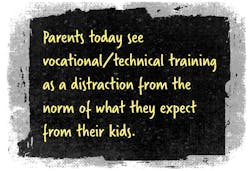Toward the end of eighth grade, I was called to the principal’s office after school—not an unusual event for me. As I tried to figure out which prank had caught up with me this time, I entered the office to face the stare of our stern-faced principal, Mr. Smith, who barked, “Sit down, Sedam.” Within a minute, the always smiling industrial-arts teacher, Mr. Hopkins, walked in, followed by ex-college-jock, GTO-driving, heartthrob history teacher, Mr. Derheimer. Smith cut right to the chase: “Sedam, I should disqualify you for any number of reasons, but it seems both Derheimer and Hopkins picked you to receive the gold medal in their courses this year. You’re only allowed one. Your choice.”
Our junior high had a tradition of giving out a “gold medal” for the top student in each class. This was a bad idea back then because, well, is there any group more brutal than adolescent eighth graders? Today, I question a process that produces just a few winners and perhaps 100 times as many losers—a big net loss. Regardless, I was up for two of these and had to choose. Mr. Hopkins, my favorite teacher, taught shop class. Each year the eighth grade classes took on projects to build something to sell and make money for a charity, such as a bookshelf. The typical take was about $75 (in 1966 dollars, worth about $550 today) from the 25 kids in a class, each making their own item from a common plan, then selling it for an average of three bucks, usually to a parent or grandparent. The quality ranged from quite good to virtually unpresentable.
Then fate intervened. For our eighth grade Honor Roll trip, we ventured to Detroit to tour the new Ford Mustang plant, right before the first model came out. It made a big impression and each of us was given a book about Henry Ford’s assembly line for the Model T and other pioneering manufacturing methods. I actually read it and found it fascinating. So much so, that I proposed to Mr. Hopkins a system whereby we sell a far better bookshelf that we could build in quantity with an assembly line, much faster, and with superior quality. This bookshelf folded up with hinges and had movable dowels that fit into predrilled holes across the base, providing 100 options for adjustment. It turned out that students at local Earlham College loved them and we sold more than 100 for an average of $5. That $500 ($3,700 today) blew away every other class, and we were all proud of our work. So for that project, Mr. Hopkins had decided to award me the medal.
What had I done in history class? I guess it was this very involved report on the Battle of Gettysburg that I got carried away with, but in truth, I was much more proud of my shop-class achievement.
The end of the story is that Mr. Derheimer took over the meeting, explaining that since I was “college material” (my mother was a teacher in the system and my father was a college professor), it made sense for me to take the history medal, while one of the guys going the “trade route” (he knew then?) would benefit more from the shop class award. Everyone nodded, so I nodded along and it was thus decided.
Later, at my high school, where exactly 12 of our 103 graduates went to college, I was always vectored away from the shop classes where I wanted to learn how to rebuild an engine, turn wood on a lathe, and weld. Instead, I was steered to Calculus, Spanish IV, and Advanced Physics. Most of that other stuff I’ve picked up over time, but welding … well, I still want to take a welding class.
College Night
Fast forward 25 years and I am attending my first “college night” with my oldest son at our local high school, one where 97 percent of the graduates enter college. There were no shop classes at this high school. Just about every college and university of any note was represented—all the Midwestern schools as well as many from the East Coast, South, and even the West. The military branches were there, hoping to attract ROTC candidates for the various schools. I stood next to the principal, a good guy now long-since retired, and observed to him that there was an entire category of schools missing. In response to his puzzled look, I explained that I saw no booths from the various vocational and technical training schools in our area—from HVAC to hairdressing to the two-year health sciences programs. He looked at me, sighed, then explained how he’d fought that battle in the past and lost. The simple fact was that in a school where better than 95 percent of the students go off to college, parents saw vocational-technical training as a distraction from the norm of what they expect from their kids. Hence none of those schools were invited.
This scenario has played out across the country to the point that shop class has virtually disappeared from high schools and middle schools. Presuming they’d even learn of the opportunity, if kids want to take a stab at learning a trade, they must first finish school, or if they’re lucky, they may have a local vo-tech school that’s cooperating with their high school. Plus there’s the parental and societal “four-year-college-or-bust” mentality to overcome. This is decidedly not the case in Canada or most European countries, where obtaining a trade certificate or two-year technical degree is considered an honorable pursuit. Our nationwide attitude to trade education and trades as a career is a huge part of the trade shortage problem we face today.
In my article last month about the Home Builders Institute (“The Best-Kept Secret in Solving the Trade Shortage”), I noted that one of the biggest obstacles was moving the training that HBI offers back into high-school curricula. Researching HBI led me to many hardworking and innovative folks around the country who are having success at the high-school level. One group among many impressive efforts struck me because, in the process, they had cracked the nut on perhaps the greatest hurdle of all: getting builders involved at the local level. If you travel to Colorado Springs, Colo., you’ll quickly see what I mean, including a radical model that solves a third major obstacle: funding for the new curriculum, instructors, and space to conduct the training.
Innovation in Colorado Springs
George Hess, president of long-time Colorado Springs builder Vantage Homes, had fretted for years over the declining trade base and the way in which schools were leaving students who may have shown an interest in vo-tech out in the cold. Hess worked on multiple efforts, such as a job fair for women in construction, and served on the board for the Career Building Academy, where they tried to start a separate school focused on trade and technical education. Although that effort was abandoned, he saw young people get excited about something they did in school, for a change. The carrot was that if students did well in other classes such as math or English, they got to go work on a construction site.
Hess found those schools that did teach what was commonly called “Industrial Arts” went beyond what home builders need. His search for basic skills in carpentry and mechanical trades led him to HBI and its curriculum. As I mentioned last month, Hess and his team saw the HBI coursework and were shocked. “We had no idea this existed!” he says. In 2015, after linking up with the Colorado Springs HBA and getting buy-in from HBI, the so-dubbed “Careers in Construction” team went to local school districts with some trepidation, saying they could supply the school with curriculum and some funding for an instructor and equipment, but would the school step up and take the risk? To everyone’s surprise, each school said yes. It had dawned on the schools that not every kid should go to college—and here was a solution.
Show Me the Money!
The new curriculum was launched first in the Harrison District for at-risk students, but soon the program went mainstream. Hess and his team found private donations for the instructor and got grants for tools. District #49 launched last spring and several more will launch this year, bringing the enrollment above 250. By the end of 2018, Hess expects 12 to 15 high schools to be participating, with enrollment as high as 1,500 to 2,000 students. The team found a few older schools with unused shop facilities, but, like most things, money was an obstacle. The per-student cost of vo-tech training is higher than more typical high-school classes. Instructors with the required knowledge are more expensive, and equipment and space demands are greater. Then, in one of their meetings, out of a long group discussion emerged an idea, one that I’d never heard of or imagined: What if we could get builders to voluntarily add another $25 per house permit to fund the student training? And what if we could get $6 per permit for roofing, electrical, HVAC, etc.? It would be to their own benefit and it would add up fast. In Colorado Springs, this is now called the “Building Futures Fund,” and today it’s a reality.
And the great news is, the fund is working. Six-figure dollars are coming through and there is the potential to generate $400K to $500K. Meanwhile, other local Colorado Springs builders are involved with the HBA in helping to develop lesson plans for the HBI curriculum, selling the permit fee idea to builders and trades, recruiting students to the program, and doing mentoring. One builder engaged in the process is John Bissett, president of JM Weston Homes, who served as president of the local HBA in 2013. John himself is proud of and quick to point out that despite his mother’s protestations he came right out of high school into auto-body work because he was good at it and wanted to be independent at age 19. Although John eventually earned a college degree, he is adamant that kids need alternatives and that parental and societal norms and expectations must be reset. Bissett describes how a group of builders led by Joe Loidolt, president of Classic Homes, got together to work with the local HBA and HBI to nail down the parts of the curriculum that were most needed. They also got suppliers to contribute and involved groups such as the Associated General Contractors. Finally, he notes that the Regional Building Department and especially the “front-counter folks” were very cooperative and just wanted to help wherever they could. Very quickly, this became a win-win for all constituencies—most of all for the students.
Wait-Listing Progress
Marla Novak, director of government affairs for the local HBA, is vocal about the HBA’s commitment to the Careers in Construction process and working with builders and school districts on programs such as matching mentors to get the skills placed where needed. Novak describes how remarkable it is to see so many different elements—sometimes with competing interests—come together to make a dream a reality in Colorado Springs. She relates that “school districts are on the waiting list,” including both public and charter schools. The HBA won’t put schools onboard, however, until it’s confident about funding. Yet today, the single-family permit participation rate in the funding is 84 percent; better than the original goal of 80 percent, and it’s growing. With that level of contribution, the future of the process appears to be secure. The HBA is now working with HBI to make Careers in Construction a “franchisable process,” eliminating the need for other cities to reinvent the wheel. Meanwhile, the HBA is happy to answer inquiries about the program and what it has learned to date.
I asked John Bissett how to get builders involved at the local level because I’m convinced this is the ultimate driver. When builders finally accept that trade development enables their own success, funding will cease to be an obstacle. “This process isn’t attractive to those looking for overnight change,” Bissett says. “The attitude of the industry, the high schools, and the parents must change. But should you get involved? Absolutely! This is an investment in your business and future. Some things we do just because it’s the right thing, and now is the time to be doing it.”
Shop class is back and it can have a huge impact on the trade shortage. Do the math. Colorado Springs is the 79th largest MSA in the country. Just imagine if the top 100 markets could graduate an average of 500 students per year. An addition of 50,000 annually to the skilled trade pool will make an incredible difference, but these students need your help. You can organize, recruit, mentor, teach, fund … no end of roles are available. The industry needs this training. The industry needs your company. The industry needs you. You can just move on and figure someone else will take care of it, or you can call your local HBA/BIA and offer your help, or maybe the help of your entire company. Meanwhile, I am off to welding class. It’s about time.
About the Author

Scott Sedam
Scott Sedam is president of TrueNorth Development, a consulting and training firm that works with builders to improve products, process, and profits. A senior contributing editor to Pro Builder, Scott writes about all aspects of the home building business and won the 2015 Jesse H. Neal Award, business journalism's most prestigious prize, for his commentary in Pro Builder. Scott invites you to join TrueNorth's Lean Building Group on LinkedIn and welcomes your feedback at [email protected] or 248.446.1275.



